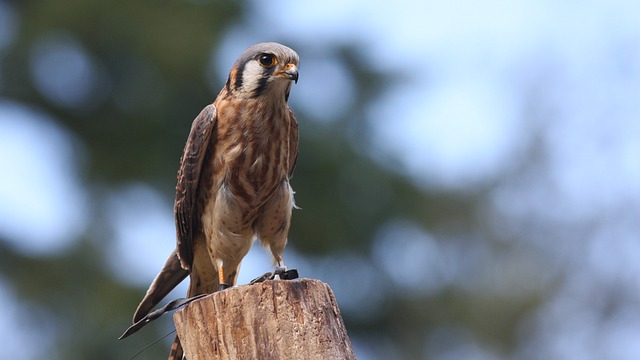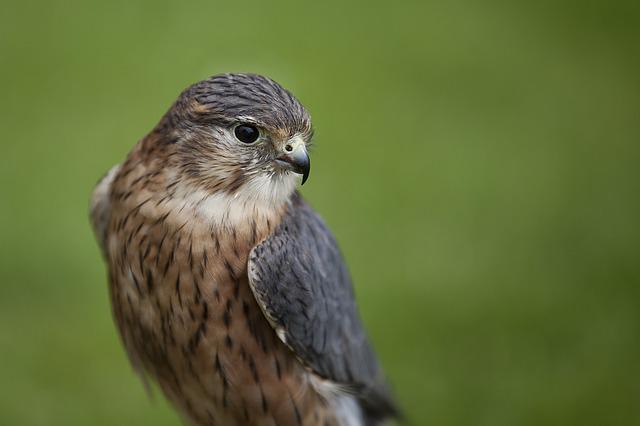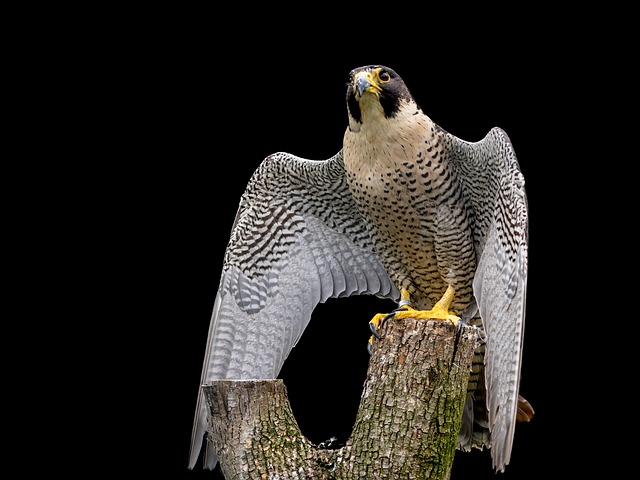Small birds of prey known as falcons are renowned for their ferocity and speed. They are amazing to see, and coming across one in the wild is really exciting.
The American Kestrel, Merlin, and Peregrine falcons are the three varieties of falcons that may be found in Pennsylvania.
The types of falcons found in Pennsylvania, their habitats, and their daily lives will all be covered in this article.
| Image | Name |
|---|---|
 | American Kestrel |
 | Merlin |
 | Peregrine Falcon |
Different Species of Falcons of Pennsylvania (PA)
1. American Kestrel

The smallest falcon in North America is the American Kestrel. A little kestrel weighs between 3 and 6 ounces, which is equivalent to around 34 cents.
American Kestrels frequently go on family hunts. The young birds get an opportunity to practice hunting with their parents before having to fend for themselves.
One of only three raptor species in Pennsylvania with drastically differing male and female physical characteristics is the American Kestrel.
Females have multiple black bars on their orange tail feathers and orange wings with black stripes, while males have blue-hued wings and just one black bar.
Where Can You Find Them?
Consider taking time to search for a little, colorful bird if you happen to be walking along a roadside or in an open area. You probably will encounter an American Kestrel at some point.
They may be seen best sitting on power wires, sometimes bobbing their tails as they search for prey. They may also be spotted munching on food from atop a power pole or hovering over a field, waiting for the ideal opportunity to attack a lizard or rodent that is unaware of their presence.
During the summer breeding season, they may be found in Canada and Alaska, which is part of their northern range. During the chilly winter months, a large portion of their prey hibernates or migrates, so they must go to where the food is.
Habitat
American Kestrels typically migrate as far south as Panama and the Caribbean during the winter, south of the Canadian border.
They may be found in a range of environments, such as deserts, urban areas, and agricultural fields, in addition to tropical lowlands. Kestrels are likely to be present if there are enough perches, such as power lines and trees, appropriate nesting chambers, and an abundance of prey.
How Do They Fly?
One of Pennsylvania’s most attractive falcons is the American Kestrel. This little raptor is a fantastic eye-catcher because of its blue, red, grey, brown, and black feather designs! Along with being attractive, American Kestrels fly quickly and have amazing aerobatic skills.
Kestrels are excellent hoverers, as are a select few other raptors. Kestrels can actively flap their wings and use their tail to stay in one place, like a helicopter in mid-air, while scouting the ground for prey with the aid of a strong headwind.
The kestrel, while being a tiny bird, requires strength, agility, and endurance to sustain its motionless flying. Observe how the kestrel’s wings, tail feathers, head, body, and even feet alter in shape and direction as it is in flight to better understand how this magnificent bird manages to do such aerial feats.
What Do They Consume?
Because they mostly eat insects, mice, voles, lizards, and snakes, American Kestrels are a great companion to farmers.
American Kestrels, like the Barn Owl and many other raptors, assist in keeping agricultural areas clear of animals that may harm crops.
American Kestrels hunt by either hovering in the air or perching above an open area to look for prey. A kestrel will do a “stoop” when it detects its prey in order to grab it. Kestrels may also catch animals in the air.
Kestrels will bring their prey up to a perch where they may comfortably devour it once they have caught it. They are protected from ground predators since they are high above, but they still need to be on the lookout for other birds who could try to eat their prey or attack them.
Reproduction
Kestrels don’t construct their own nests as other falcons do. Instead, they nestle their eggs inside of cliffs, cacti, and trees. They can even make their nests in human-made nesting boxes or in cracks in structures.
Although kestrels nest in tree cavities, it is crucial to remember that they cannot create these cavities on their own. They depend on other birds, like woodpeckers, to do the task of finding them excellent locations!
In actuality, an American Kestrel won’t make a nest unless there is a large enough hole present in a tree, structure, or nesting box. The population and reproduction of this species are constrained by a shortage of adequate nesting chambers.
Together, the male and female spend a lot of time courting, reproducing, and rearing offspring. The female kestrel is given presents by the male during courting, although she isn’t into flowers or chocolates. She likes dead lizards or decapitated mice much more!
Typically, females deposit four to six white eggs with dark markings. The female and male both contribute to egg incubation.
The eggs are sat on by the adults as they incubate them to maintain the ideal temperature. The baby chicks within need this for healthy growth.
2. Merlin

The Merlin is a diminutive member of the Falconidae family of falcons. Along with Eurasia and northern Africa, they are found all across North, Central, and certain areas of South America.
These birds, like other falcons, are expert hunters that often catch their prey on flight. They can navigate effectively when seeking prey because of their slender wings. Learn more about the Merlin by reading on.
The majority of Merlins weigh 7 to 8 ounces. They often have black, brown, or grey feathers in their plumage. Even though their undersides are cream-colored, they do have some dappling. They have razor-sharp talons and sharp, curved beaks, just like all other birds of prey.
Where Can You Find Them?
Numerous types of habitats support these birds. Large wide spaces are found in their preferred environments. Because they enjoy hunting food in the air, they prefer open settings versus woodlands.
They may be found thriving in a variety of environments, such as steppes, marshes, deserts, and grasslands. While mating, they do use wooded regions, typically coniferous or pine forests.
Merlins have an extraordinarily wide range because of their seasonal migration. They reside in northern regions in the spring and summer and move south during the winter.
Reproduction
Per clutch, female Merlins lay around five eggs. The male then hunts and gives her food while she remains on the nest, and she continues to incubate the eggs.
Both parents help to catch food for the chicks when they hatch. The chicks grow fast, and when they are approximately a month old, they start to learn how to fly.
After leaving the nest, they spend a few weeks with their parents before starting their migration to the southern wintering grounds.
What Do They Consume?
These birds, like other falcons, are carnivores and exclusively consume meat. Small types of birds are their preferred prey, which they often catch while flying.
In actuality, birds make up a significant portion of their food. They frequently hunt birds such as sparrows, ptarmigans, finches, larks, grouse, and others. They pursue other tiny creatures, including insects, lizards, frogs, mice, rats, and rabbits.
Fascinating Information About The Merlin
Merlins differ from the 40 other falcon species found across the world in a variety of ways, both in terms of adaptations and behavior.
- Work Smarter, Not Harder: These birds prefer to invade the nests of other huge birds rather than make their own. They never really construct their own nests as a result!
- Few raptors that hunt in groups are known as social raptors. The members of this elite cooperative hunting club also include Merlins. Merlins often hunt in pairs, as opposed to Harris hawks, which hunt in family groups with multiple members.
- The most frequent instance of couples hunting together is when attempting to catch flocks of birds. The duo assaults the flock from above, with one member catching stragglers who separate from the flock amid the chaos with the other.
- These birds have thriving populations, and human activity has little to no negative effects on them. Merlins are now classified as Least Concern by the IUCN. However, the effects of human activities vary according to the location and the population.
3. Peregrine Falcon

Peregrine Falcon can be seen in open regions close to cliff cliffs or buildings. Near rivers and other sources of water are where they prefer to hunt despite the fact that they also like hunting in urban areas.
While pigeons are a favored food item for city peregrines, ducks and shorebirds are their preferred prey items in wild environments.
Because they have adapted to urban settings better than other raptors, peregrines are a regular sight in major cities. They frequently construct their nests on the sills of skyscrapers. There’s a high probability a peregrine falcon is keeping an eye on a nearby flock of pigeons.
Physical Features
One of the biggest and strongest species of bird is the peregrine. They have dark blue wings and heads, long, sharply pointed wings, and a short tail.
The undersides of their wings are banded with dark lines, and they have spots on their light breast. They have a hooded expression because of their dark “mustache” and dark top of the head.
With dark brown plumage, stripes on the underside of their bodies, and pale feather tips, juvenile peregrines differ slightly from adults in appearance.
Where Do Peregrine Falcons Reside?
Most of the time, peregrine falcons hunt over marshes, estuaries, and cultivated land in the open countryside where they inhabit.
They build their nests on crags and rock faces during the mating season, including coastal cliffs, quarries, and, increasingly, structures in metropolitan areas.
While wild pigeons and starlings offer a dependable source of food, tower blocks, bridges, and cathedrals give the ideal urban alternative to steep cliffs.
Peregrine falcons from Britain and Ireland are visible all year long; however, females and young birds may leave highland locations in the fall. Populations that live further north migrate.
While some Arctic birds migrate to South America during the winter, some European peregrines spend their time in Africa. These birds may travel up to 15,500 kilometers annually!
What Food Consume Peregrine Falcons?
The majority of the food consumed by peregrine falcons comes from birds they have caught in flight, including blackbirds, starlings, woodpigeons, feral pigeons, and black-headed gulls. On rare occasions, they will also catch animals like rabbits and, during periods of severe weather, carrion.
They can chase after their prey or stoop down on it from a considerable height to attack it. A hunting peregrine falcon is moving so quickly that a direct hit may hurt it.
Thus, because of their speed, they seek to paralyze their prey with a blow before catching it as it falls. They will let the prey fall to the ground and consume it if it is too heavy for them to carry.
There are several hunting adaptations for peregrine falcons.
For instance, their nostrils direct air shock waves to prevent the high pressure from harming their lungs when they dive. A beautiful natural pattern that served as inspiration for the earliest jet engines!
Eight times greater than human vision, they have outstanding binocular vision. Over three kilometers away, they can spot their prey.
They have a third eyelid that distributes tears and clears dirt from their eyes during a stoop to protect them without hindering their vision.
Peregrine falcons typically fly towards their prey in a curve because this helps them fly quicker and allows them to see better with their heads twisted at an angle.
Reproduction
Each February, couples of peregrine falcon return to their nest and put on amazing aerial performances. The male begins by providing food for the female, frequently dropping it for her to catch mid-flight, occasionally when she is flying upside down!
The female does not utilize any other materials other than her breast and legs to create a scrape in which to lay her eggs.
She then conceives three to four eggs in March or April, incubating them for about a month while the male takes care of her nutritional needs.
Young falcons first rely on their parents for sustenance until fledging, or reaching complete independence, after around 39 days.
Conclusion
Fortunately for you, there should be at least a couple of falcon species close by wherever you reside in Pennsylvania.
Falcons are amazing raptors who are renowned for their agility and superior hunting skills. For instance, a Peregrine Falcon, one of the three falcons including Merlin and the America Kestral that are found in Pennsylvania, can dive for food quicker than any other animal on the earth.
FAQ
Which Large Birds May Be Found In Pennsylvania?
The bald eagle, golden eagle, and osprey are large, beautiful, and fascinating birds of prey that appear to exemplify strength and grandeur.
Only the bald eagle and osprey nest in Pennsylvania, while all are commonly found there. A route between its breeding and wintering grounds is used by the golden eagle throughout its migration across the state.
What Distinguishes A Falcon From A Hawk?
In contrast to hawks, which have a white band at the base, falcons have belly stripes that extend all the way to the base.
When the two species are in full flight, and you can see their wingspan, that is one of the simplest times to tell them apart. Falcon wings are thin and pointed, but hawk wings feature “fingers” on the tips.
Last Updated on March 22, 2023 by Lily Aldrin

